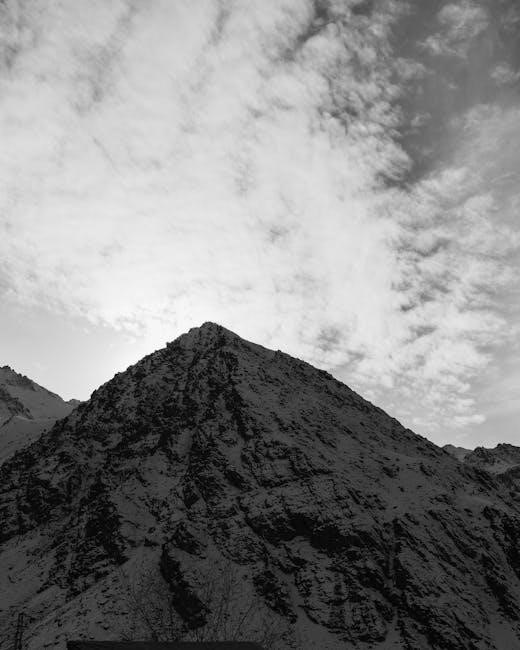
Mountains hold profound spiritual and historical significance in the Bible, often symbolizing divine encounters, sacred spaces, and pivotal events in God’s plan. Their prominence shapes key biblical narratives.
Significance of Mountains in Biblical Narratives
Mountains in the Bible are deeply symbolic, often representing divine encounters, spiritual transformation, and pivotal moments in God’s plan. They serve as stages for revelation, worship, and significant events, such as the giving of the Ten Commandments on Mount Sinai. These high places symbolize closeness to God, as seen in Jesus’ Sermon on the Mount and His frequent retreats to mountains for prayer. Mountains also signify challenges and spiritual battles, like Moses’ final view of the Promised Land from Mount Nebo. Their prominence underscores themes of faith, obedience, and God’s covenant with humanity. From Mount Ararat, where the ark rested, to the Mount of Olives, where Jesus ascended, mountains are integral to the Bible’s narrative, embodying both natural grandeur and spiritual significance.
Overview of the 12 Key Mountains Mentioned in Scripture
The Bible references numerous mountains, each holding unique significance in biblical history and theology. Among these, 12 mountains stand out as pivotal locations shaping key events and spiritual moments. From Mount Ararat, where Noah’s ark rested, symbolizing a new beginning, to Mount Sinai, the site of the Ten Commandments, these mountains are central to God’s covenant with humanity. Mount Moriah, the location of Abraham’s near-sacrifice of Isaac, and Mount Carmel, where Elijah confronted the prophets of Baal, highlight divine intervention and faith. Mount Horeb, also linked to Moses, and Mount Gerizim, associated with blessings, further illustrate the diversity of their roles. The Mount of Olives, a frequent retreat for Jesus, and Mount Zion, a symbol of Jerusalem and God’s presence, are among these significant sites. Each mountain serves as a backdrop for profound spiritual and historical events, reflecting God’s interaction with humanity and the fulfillment of His plan.

Prominent Mountains in the Bible
Mountains in the Bible are spiritual high points, central to key events and theological themes. They symbolize divine encounters, covenants, and transformative moments in God’s relationship with humanity.
Mount Ararat
Mount Ararat, standing at 5,137 meters, is a pivotal location in biblical history. It is famously known as the resting place of Noah’s ark after the great flood (Genesis 8:4). This mountain holds immense significance as a symbol of divine deliverance and renewal. Its snow-capped peak has become an iconic representation of God’s covenant with humanity. Mount Ararat is also recognized for its strategic location in modern-day Turkey, making it a focal point in biblical geography. The ark’s resting here signifies the end of judgment and the beginning of a new era. This mountain is not only a historical landmark but also a powerful reminder of God’s faithfulness and mercy. Its mention in Scripture underscores its role in shaping the narrative of salvation and redemption.Mount Ararat remains a subject of fascination for scholars and believers alike, connecting the biblical account with the physical world.
Mount Sinai
Mount Sinai, standing at 2,285 meters, is one of the most significant mountains in the Bible. It is often referred to as the “Mountain of God” and is best known as the site where God revealed the Ten Commandments to Moses (Exodus 20:1-17). This event is central to the Israelites’ covenant with God, marking a pivotal moment in their history. The mountain is also associated with the giving of the Law and the establishment of moral and spiritual guidelines for humanity. In some texts, it is referred to as Mount Horeb, where Elijah encountered God in a still, small voice (1 Kings 19:11-12). Located in the Sinai Peninsula, Mount Sinai remains a sacred and symbolic location, representing divine revelation and the presence of God. Its rugged terrain and historical significance make it a focal point in biblical narratives and a place of deep spiritual importance.
Mount Moriah
Mount Moriah is a mountain of profound biblical significance, primarily known as the site where Abraham was willing to sacrifice his son Isaac as an act of obedience to God (Genesis 22:2, 9). This event, a pivotal moment in biblical history, showcases Abraham’s unwavering faith and trust in God’s promises. The mountain is also associated with the Temple Mount in Jerusalem, where King Solomon later built the First Temple (2 Chronicles 3:1). Its name, meaning “chosen by God,” reflects its sacred role in Israel’s history. Mount Moriah symbolizes sacrifice, faith, and divine provision, making it a cornerstone in the narrative of God’s relationship with His people. Its historical and spiritual importance continues to resonate in Jewish and Christian traditions, marking it as a central location in biblical geography and theology.
Mount Carmel
Mount Carmel holds significant biblical importance, particularly as a symbol of divine power and judgment. It is most famously known as the site where the prophet Elijah confronted the prophets of Baal, challenging them to a contest to prove the true God (1 Kings 18:19-40). Elijah’s victory, marked by fire descending from heaven, demonstrated God’s sovereignty and strengthened the Israelites’ faith. Located in modern-day Israel, Mount Carmel is a coastal mountain range near the city of Haifa, known for its lush vegetation and natural beauty. The name “Carmel” means “garden” or “orchard,” reflecting its fertile landscape. Beyond its role in Elijah’s story, Mount Carmel has been a symbol of beauty and divine intervention throughout history, making it a cherished site in biblical and cultural heritage. Its legacy continues to inspire faith and reflection for people around the world.
Mount Horeb
Mount Horeb is a mountain deeply rooted in biblical history and spiritual significance. It is often identified as the same mountain as Mount Sinai, where Moses encountered the burning bush and received the Ten Commandments (Exodus 3:1-15). This sacred site symbolizes divine revelation and covenant-making. Moses also returned to Mount Horeb after fleeing Egypt, where God spoke to him in a profound moment of calling (Exodus 3:1-10). The mountain serves as a place of divine encounter, emphasizing God’s presence and guidance. Its prominence in the wilderness narratives underscores its role in shaping Israel’s identity and faith. Mount Horeb remains a powerful symbol of God’s revelation and covenant promises, reflecting the enduring significance of mountains in biblical theology. Its legacy continues to inspire reflection on divine communication and the foundation of spiritual truths.
Mount Gerizim
Mount Gerizim is a significant mountain in the Bible, located near the city of Shechem in the region of Samaria. It holds great religious importance, particularly for the Samaritans, who considered it a sacred site rivaling Jerusalem. The mountain is mentioned in the Bible as the location where the Samaritans built a temple, which became a point of contention between the Samaritans and the Jews (John 4:20-21). In Deuteronomy 11:29 and 27:12, Mount Gerizim is designated as the site for pronouncing blessings upon the Israelites as they entered the Promised Land. Jesus also encountered a Samaritan woman at the well near Mount Gerizim, where He emphasized that true worship is not confined to a specific location but is done “in spirit and truth” (John 4:19-24). This mountain symbolizes the complex religious and cultural dynamics between Samaritans and Jews, highlighting its enduring significance in biblical history.
Mount of Olives
The Mount of Olives, standing at 826 meters, is a highly significant location in the Bible, prominently featured in both the Old and New Testaments; It is situated near Jerusalem and serves as a backdrop for numerous pivotal events in Jesus’ ministry. The mount is where Jesus often prayed and taught His disciples, including the Lord’s Prayer (Luke 11:1-4). It is also the site of His Triumphal Entry into Jerusalem (Matthew 21:1-11) and His Ascension into heaven (Acts 1:9-12). Additionally, the Garden of Gethsemane, where Jesus prayed before His arrest, is located on the Mount of Olives (Matthew 26:36-46). This mountain holds deep theological significance, symbolizing both divine presence and the ultimate sacrifice of Christ. Its importance is further emphasized in Zechariah 14:4, which prophesies Jesus’ return to the same mountain, making it a central symbol in Christian eschatology.

Mount Abarim

Mount Abarim, located near the border of Moab, holds significant importance in biblical history. It is notably mentioned as the site from which Moses viewed the Promised Land before his death, as recorded in Deuteronomy 32:49-50 and 3:27. This mountain symbolizes the transition point for the Israelites, marking the end of Moses’ leadership and the eve of their entry into Canaan. Additionally, it is associated with the instruction to appoint cities of refuge, as outlined in Numbers 35:13-14. Mount Abarim serves as a poignant reminder of divine providence and the fulfillment of God’s promises to His people. Its strategic location and historical events make it a meaningful landmark in the biblical narrative, reflecting themes of hope, transition, and obedience. This mountain remains a powerful symbol of God’s faithfulness and the culmination of a journey.
Mount Tabor
Mount Tabor is a significant biblical site located in the Jezreel Valley, near Nazareth. It is famously known as the place where Gideon, with just 300 men, defeated the Midianites, showcasing divine intervention and faith (Judges 4:12). Additionally, Mount Tabor is traditionally associated with the Transfiguration of Jesus, where He revealed His divine glory to Peter, James, and John (Matthew 17:1-13, Mark 9:2-13, Luke 9:28-36). While the Bible does not explicitly name Mount Tabor as the location, Christian tradition has long linked it to this pivotal event. The mountain symbolizes spiritual revelation and transformation, making it a revered site in both Old and New Testament contexts. Its historical and theological importance continues to inspire faith and reflection.
Mount Zion
Mount Zion is deeply rooted in biblical history and theology, primarily associated with Jerusalem and the Temple. It is often referred to as the “City of David” and serves as a symbol of God’s presence among His people. The Bible highlights its significance in key events, such as King David’s establishment of Jerusalem as Israel’s capital and the placement of the Ark of the Covenant there (1 Chronicles 11:5, 2 Chronicles 5:2). Mount Zion is also linked to the crucifixion of Jesus, as the Last Supper occurred in an upper room on its slopes (Luke 22:7-20). In the New Testament, it is further associated with the birth of the Church, as the Holy Spirit descended upon the disciples during Pentecost (Acts 2:1-4). Mount Zion remains a powerful symbol of divine kingship, redemption, and the eternal presence of God. Its legacy endures in Christian worship and eschatological hope.
Mount Hermon

Mount Hermon, standing at 9,200 feet, is the highest mountain in the region of Palestine and holds significant biblical and cultural importance. Located in the Anti-Lebanon mountain range, it borders modern-day Lebanon, Syria, and Israel. The Bible refers to Mount Hermon in Deuteronomy 3:8-9, where it marks the northern boundary of the land promised to Israel. It is also mentioned in Psalm 133:3, symbolizing divine blessing and unity. Historically, Mount Hermon was a place of worship for various cultures, including the ancient Canaanites. In the New Testament, it is near Caesarea Philippi, where Jesus had a profound conversation with His disciples about His identity (Matthew 16:13-20). Some scholars also associate it with the possible location of the Transfiguration (Matthew 17:1-13). Mount Hermon’s grandeur and biblical references make it a symbol of divine encounter and revelation.

Mount Nebo
Mount Nebo, standing at 2,680 feet, is a significant biblical site located in modern-day Jordan, opposite Jericho. It is renowned as the mountain from which Moses viewed the Promised Land before his death (Deuteronomy 32:49-50, 34:1-6). This moment marks the end of Moses’ journey and the transition of leadership to Joshua. The Bible describes how God showed Moses the entire land He had sworn to give to Abraham, Isaac, and Jacob, emphasizing the fulfillment of His promises. Mount Nebo is also associated with the bronze serpent (Numbers 21:9), a symbol of redemption and healing. Today, Mount Nebo is a revered pilgrimage site, offering stunning views of the Jordan River and the Dead Sea. Its historical and spiritual significance continues to inspire faith and reflection.